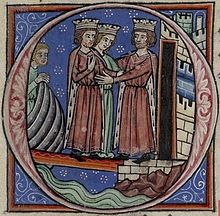Joan of England, Queen of Sicily
| Joan of England | |
|---|---|
 Joan and Richard I greet Philip II of France | |
| Queen consort of Sicily | |
| Tenure | 13 February 1177 – 11 November 1189 |
| Coronation | 13 February 1177 |
| Countess consort of Toulouse | |
| Reign as consort | October 1196/7 – 4 September 1199 |
| Burial | Fontevrault Abbey |
| Spouse | William II of Sicily m. 1177; dec. 1189 Raymond VI of Toulouse m. 1196/7; wid. 1199 |
| Issue | Raymond VII of Toulouse |
| House | House of Plantagenet (by birth) Hauteville Dynasty (by first marriage) House of Rouergue (by second marriage) |
| Father | Henry II of England |
| Mother | Eleanor of Aquitaine |
Joan of England (October 1165 – 4 September 1199) was the seventh child of Henry II of England and his queen consort, Eleanor of Aquitaine.
Joan was a younger maternal half-sister of Marie de Champagne and Alix of France. She was a younger sister of William IX, Count of Poitiers, Henry the Young King, Matilda, Duchess of Saxony, Richard I of England, Geoffrey II, Duke of Brittany and Leonora of Aquitaine. She was also an older sister of John of England.
Queen consort of Sicily
Joan was born at Château d'Angers in Anjou, and spent her youth at her mother's courts at Winchester and Poitiers. In 1176, William II of Sicily sent ambassadors to the English court to ask for Joan's hand in marriage. The betrothal was confirmed on 20 May and on 27 August Joan set sail for Sicily, escorted by John of Oxford, the bishop of Norwich and her uncle, Hamelin de Warenne, 5th Earl of Surrey. In Saint Gilles, her entourage was met by representatives of the Kingdom of Sicily: Alfano, Archbishop of Capua, and Richard Palmer, Bishop of Syracuse.
After a hazardous voyage, Joan arrived safely, and on 13 February 1177, she married William II of Sicily and was crowned Queen of Sicily at Palermo Cathedral. They had one son, Bohemond, born in 1181 and who died in infancy. Following William's death in 1189, she was kept a prisoner by the new king, Tancred of Sicily.
Third Crusade
Finally, her brother Richard I of England arrived in Italy in 1190, on the way to the Holy Land. He demanded her return, along with every penny of her dowry. When Tancred balked at these demands, Richard seized a monastery and the castle of La Bagnara. He decided to spend the winter in Italy and attacked and subdued the city of Messina. Finally, Tancred agreed to the terms and sent Joan's dowry. In March 1191 Eleanor of Aquitaine arrived in Messina with Richard's bride, Berengaria of Navarre.
Eleanor returned to England, leaving Berengaria in Joan's care. Richard decided to postpone his wedding, put his sister and bride on a ship, and set sail. Two days later the fleet was hit by a fierce storm, destroying several ships and blowing Joan and Berengaria's ship off course. Richard landed safely in Crete, but they were stranded near Cyprus. The self-appointed despot of Cyprus, Isaac Comnenus was about to capture them when Richard's fleet suddenly appeared. The princesses were saved, but the despot made off with Richard's treasure. Richard pursued and captured Isaac, threw him into a dungeon, and sent Joan and Berengaria on to Acre.
Joan was Richard's favourite sister, but he was not above using her as a bargaining chip in his political schemes. He even suggested marrying her to Saladin's brother, Al-Adil, and making them joint rulers of Jerusalem. This plan fell apart when Joan refused to marry a Muslim and Al-Adil refused to marry a Christian. King Philip II of France also expressed some interest in marrying her, but this scheme, too, failed (possibly on grounds of affinity, since Philip's father Louis VII had formerly been married to her mother).
Countess of Toulouse
Joan was married in October 1196, at Rouen, to Raymond VI of Toulouse, with Quercy and the Agenais as her dowry. She was the mother of his successor Raymond VII of Toulouse, and a short lived daughter (1198).
This new husband treated her none too gently, however, and Joan came to fear him and his knights. In 1199, while pregnant with a third child, Joan was left alone to face a rebellion in which the lords of Saint-Félix-de-Caraman were prominent. She laid siege to their castle at les Cassès but was menaced by treachery. Escaping this threat, Joan travelled northwards, hoping for her brother's protection, but found him dead at Château de Chalus-Chabrol.[1] She then fled to her mother Queen Eleanor's court at Rouen, where she was offered refuge and care.
Joan asked to be admitted to Fontevrault Abbey, an unusual request for a married, pregnant woman, but this request was granted. She died in childbirth and was veiled a nun on her deathbed. Her son lived just long enough to be baptised (he was named Richard). Joan was thirty-three years old. She was buried at Fontevrault Abbey, and fifty years later her son Raymond VII would be interred next to her.
Depictions in fiction
The Plantagenet romance novelist Molly Costain Haycraft wrote a fictionalized account of Joan's life, beginning with the death of her first husband, in the book My Lord Brother the Lionheart.
In the 1965 Doctor Who serial The Crusade, Joan (called "Joanna" in the serial) is played by Jean Marsh; the story includes Richard's attempt to marry Joan to Saladin the Great.
Notes
- ^ Guillaume de Puylaurens (Duvernoy 1976, pp. 44–47)
Historical sources
References
- Payne, Robert. The Dream and the Tomb, 1984
- Owen, D.D.R. Eleanor of Aquitaine: Queen and Legend
- Wheeler, Bonnie. Eleanor of Aquitaine: Lord and Lady, 2002
